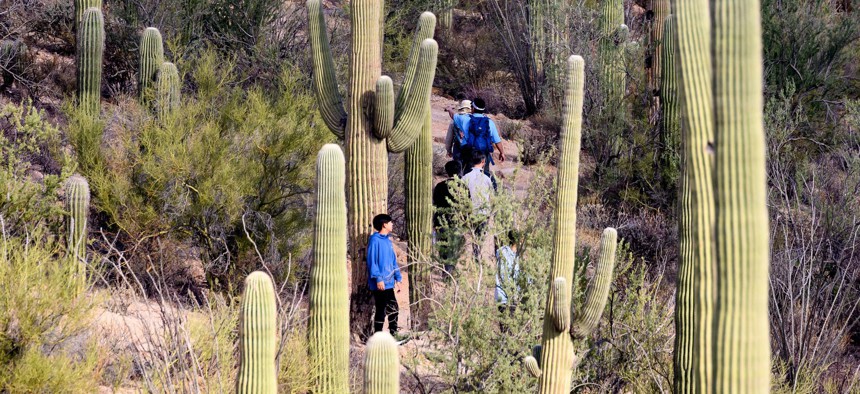Key takeaways from the Explore Act, one of the largest outdoor recreation bills ever

Hikers walk along a trail in Saguaro National Park near Tucson, Arizona on November 19, 2023. JOSH EDELSON/AFP via Getty Images
The proposal will streamline the permitting process for outdoor recreation companies, study internet access at National Parks, identify potential long distance bike trails and paths, and support recreation and tourism economies and towns.
This story was first published by the Utah News Dispatch. Read the original here.
The U.S. House of Representatives threw its support behind one of the country’s largest ever bills focused on outdoor recreation last week, sending the Expanding Public Lands Outdoor Recreation Act to the Senate with unanimous approval.
Known as the Explore Act, the 220-page package seeks to streamline the permitting process for outdoor recreation companies, study internet access at National Parks, identify potential long distance bike trails and paths, support recreation and tourism economies and towns, and allow for new rock climbing routes on public land.
Many of the provisions come from Utah Republican Rep. John Curtis, who called it “a testament to our collective commitment to enhancing and preserving access to America’s stunning public lands and waters.”
In addition to receiving bipartisan support in the House, the bill got a thumbs up from outdoor and environmental advocacy groups like the Sierra Club, the Outdoor Industry Association and the Specialty Equipment Market Association, which promotes motorized recreation and off-roading.
The Simplifying Outdoor Access for Recreation Act is designed to ease the burden on companies that rely on outdoor recreation permits to work on public land, like outfitters, educational organizations or community groups. It would:
- Shorten the wait time and environmental review in the permit application process.
- Allow for a sharing program for unused permits, create more short-term permits to expand recreation opportunities, and allow outfitters and guides to engage in recreation that is similar to yet slightly outside the scope of their permit.
- Allow a joint permit for trips and operations that cross into public lands managed by different agencies—for instance, a guided skiing trip that spans both Bureau of Land Management and U.S. Forest Service land.
The Protecting America’s Rock Climbing provision would recognize rock climbing as an accepted use within the National Wilderness Preservation System, a network of roughly 112 million acres of wilderness land managed by the U.S. Forest Service. It allows for the maintenance of fixed climbing routes already in wilderness areas, and the creation of new routes.
The Connect Our Parks provision would study where the “greatest need” is for broadband internet and cellular service in the country’s national parks. Once the study is complete, the Department of Interior would create a plan to expand service in the highlighted areas.
The Biking On Long Distance Trails provision would study routes that could support a long distance bike trail, creating a public comment process that would result in a two-year report. The act would also expand mapping resources for trail users, including publishing and distributing maps of the identified trails. The Bonneville Shoreline Trail, which winds along the foothills of the Wasatch Front, could be identified and expanded under this act.
The Range Access provision is similar, and directs the Forest Service and Bureau of Land Management to identify areas suitable for a target shooting range. Contingent on funding, the agencies are then directed to establish and maintain a shooting range.
The Supporting Gateway Communities And Addressing Park Overcrowding provision directs the U.S. Department of Interior and the U.S. Department of Agriculture to work with state and local governments to address housing shortages and visitation management. The USDA could use low-interest loan and vocational training programs to assist gateway communities—like Moab or Springdale—to “expand infrastructure to accommodate and manage sustainable visitation, including hotels, campgrounds, and restaurants.”
The Parking And Restroom Opportunities For Federal Recreational Lands and Waters provision seeks to improve parking and bathroom infrastructure on federal lands by allowing public-private partnerships. The federal government could contract with a local government or private entity on non-federal land to expand parking access—it also directs the Department of the Interior to develop “innovative” new public restroom designs or partnerships.
The Access For People With Disabilities provision requires the Department of the Interior to study accessibility of camping facilities, shooting ranges, boat launch ramps and more on federal land. It would also require the government to survey and improve accessibility on trails for people with disabilities. Public land agencies like the Forest Service and Bureau of Land Management would be required to create new “accessible recreation opportunities” for people with disabilities—that includes bike trails, camp shelters, water or snow sports, or motorized recreation.





